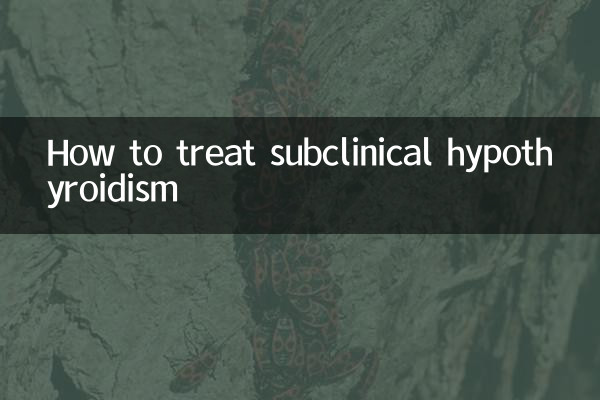How to treat subclinical hypothyroidism
Subclinical hypothyroidism (subclinical hypothyroidism) is a common thyroid disease manifested in elevated serum thyroid stimulating hormone (TSH) levels while normal free thyroxine (FT4) levels. In recent years, with the improvement of health awareness, the treatment of subclinical hypothyroidism has become a hot topic. This article will combine the hot topics on the entire network over the past 10 days to introduce you in detail the treatment methods of subclinical hypothyroidism and provide structured data for reference.
1. Overview of subclinical hypothyroidism

Subclinical hypothyroidism is the early stage of hypothyroidism. Patients may have no obvious symptoms, but long-term untreated treatment may lead to complications such as cardiovascular disease and metabolic abnormalities. According to recent hot discussions, the incidence of subclinical hypothyroidism is on the rise, especially middle-aged and elderly women and pregnant women need to be more vigilant.
2. Treatment methods for subclinical hypothyroidism
The treatment of subclinical hypothyroidism requires a personalized plan based on the patient's specific situation. Here are the mainstream treatments:
| Treatment method | Applicable groups | Things to note |
|---|---|---|
| Levothyroxine (L-T4) alternative treatment | TSH > 10 mIU/L or patients with symptoms | TSH levels need to be monitored regularly to avoid overdose |
| Lifestyle adjustment | Asymptomatic patients with mild elevation of TSH (4-10 mIU/L) | It is recommended to eat a balanced diet, exercise regularly, and weight control |
| Traditional Chinese Medicine Conditioning | Patients who hope to try the treatment of traditional Chinese and Western medicine | Need to be carried out under the guidance of a professional Chinese medicine practitioner |
| Regular follow-up | All subclinical hypothyroidism patients | It is recommended to check the thyroid function every 6-12 months |
3. Popular discussions recently
According to the analysis of hot content on the entire network for the past 10 days, the following topics are the most discussed:
1.Controversy in the treatment of subclinical hypothyroidism during pregnancy: There is still controversy over whether women need to actively treat subclinical hypothyroidism during pregnancy, and some experts believe that stricter control standards are needed.
2.Dosage adjustment of L-T4: How to personalize the L-T4 dose based on factors such as age, weight, and comorbidities has become a hot topic.
3.Subclinical hypothyroidism and cardiovascular risk: Several new studies have explored the relationship between subclinical hypothyroidism and arteriosclerosis and dyslipidemia.
4. Suggestions for selection of treatment plans
According to recent clinical guidelines and expert consensus, the treatment recommendations for subclinical hypothyroidism are as follows:
| TSH level (mIU/L) | Treatment advice | Follow-up frequency |
|---|---|---|
| 4-10 | Asymptomatic patients can be observed, and treatment can be considered if there are symptoms or high-risk factors. | 6-12 months |
| >10 | Recommended L-T4 treatment | 3-6 months |
| Pregnancy period >2.5 | Recommended treatment | per month |
5. Treatment precautions
1.Drug interactions:L-T4, iron, calcium, etc., needs to be taken 4 hours apart, which is one of the most frequently asked questions in recent days.
2.Dose adjustment: Dosage reduction may be required in summer and dose increase may be required in winter, which is related to recent discussion hotspots of seasonal changes.
3.Efficacy assessment: TSH should be checked after 4-8 weeks of treatment and the dose should be adjusted according to the results.
6. Prognosis and prevention
Patients with subclinical hypothyroidism have good prognosis after standardized treatment. Recent studies have shown that about 30% of subclinical hypothyroidism patients may return to normal on their own, especially those with mild TSH. In terms of prevention, recommendations:
1. Regular physical examinations, especially those with a family history of thyroid disease
2. Control iodine intake, neither lack nor excessive
3. Manage stress and avoid long-term mental tension
4. Women should pay special attention to thyroid function screening during pregnancy
Conclusion:
The treatment of subclinical hypothyroidism needs to be individualized and comprehensively made with factors such as the patient's age, symptoms, and TSH level. Recent hot discussions have emphasized the importance of pregnancy management, cardiovascular risk assessment and personalized treatment. Patients are advised to undergo treatment under the guidance of a professional doctor and to maintain regular follow-up.

check the details

check the details